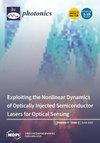Attitude Determination of Photovoltaic Device by Means of Differential Absorption Imaging
IF 1.9
4区 物理与天体物理
Q2 OPTICS
引用次数: 0
Abstract
Future wireless power transmission will cover power levels up to kilowatts or more and transmission distances up to the scale of kilometers. With its narrow beam divergence angle, optical wireless power transmission (OWPT) is a promising candidate for such system implementations. In the operation of OWPT, it is necessary to estimate the position, direction (azimuth, elevation), and attitude of the target photovoltaic device before the power supply. The authors have proposed the detection of targets using differential absorption imaging and positioning with a combination of stereo imagery. In the positioning by stereo imagery, a condition regarding the consistency of the left and right images can be defined. This corresponds to the certain value of the exposure time of the image sensor, and this depends on the target’s attitude angle. In this paper, we discuss target attitude estimation using this minimum exposure time at which the integrity measure converges. A physical model was derived under general conditions of target position and experimental configuration. Target attitudes were estimated within an error range of 10 to 15 degrees in approximately 60 degrees range. On the other hand, there is an attitude estimation method based on the apparent size of the target. When using this method to estimate the attitude angle, errors are significantly large for specular and diffuse mixed targets like the PV. The method proposed in this paper is a robust attitude estimation method for the photovoltaic device in OWPT.利用差分吸收成像确定光伏设备的姿态
未来的无线电力传输将覆盖高达千瓦或更高的功率级别和长达千米的传输距离。光学无线电力传输(OWPT)具有窄光束发散角的特点,是实现此类系统的理想选择。在 OWPT 的运行过程中,有必要在供电前估计目标光电设备的位置、方向(方位角、仰角)和姿态。作者提出了利用差分吸收成像检测目标和结合立体成像进行定位的方法。在利用立体图像定位时,可以定义左右图像一致性的条件。这与图像传感器曝光时间的特定值相对应,而曝光时间取决于目标的姿态角。在本文中,我们将讨论利用完整性测量收敛的最小曝光时间来估计目标姿态。在目标位置和实验配置的一般条件下,推导出了一个物理模型。在大约 60 度的范围内,目标姿态的估计误差在 10 至 15 度之间。另一方面,还有一种基于目标视尺寸的姿态估计方法。使用这种方法估计姿态角时,对于像光伏这样的镜面和漫反射混合目标,误差会很大。本文提出的方法是一种针对 OWPT 中光伏设备的稳健姿态估计方法。
本文章由计算机程序翻译,如有差异,请以英文原文为准。
求助全文
约1分钟内获得全文
求助全文
来源期刊

Photonics
Physics and Astronomy-Instrumentation
CiteScore
2.60
自引率
20.80%
发文量
817
审稿时长
8 weeks
期刊介绍:
Photonics (ISSN 2304-6732) aims at a fast turn around time for peer-reviewing manuscripts and producing accepted articles. The online-only and open access nature of the journal will allow for a speedy and wide circulation of your research as well as review articles. We aim at establishing Photonics as a leading venue for publishing high impact fundamental research but also applications of optics and photonics. The journal particularly welcomes both theoretical (simulation) and experimental research. Our aim is to encourage scientists to publish their experimental and theoretical results in as much detail as possible. There is no restriction on the length of the papers. The full experimental details must be provided so that the results can be reproduced. Electronic files and software regarding the full details of the calculation and experimental procedure, if unable to be published in a normal way, can be deposited as supplementary material.
 求助内容:
求助内容: 应助结果提醒方式:
应助结果提醒方式:


